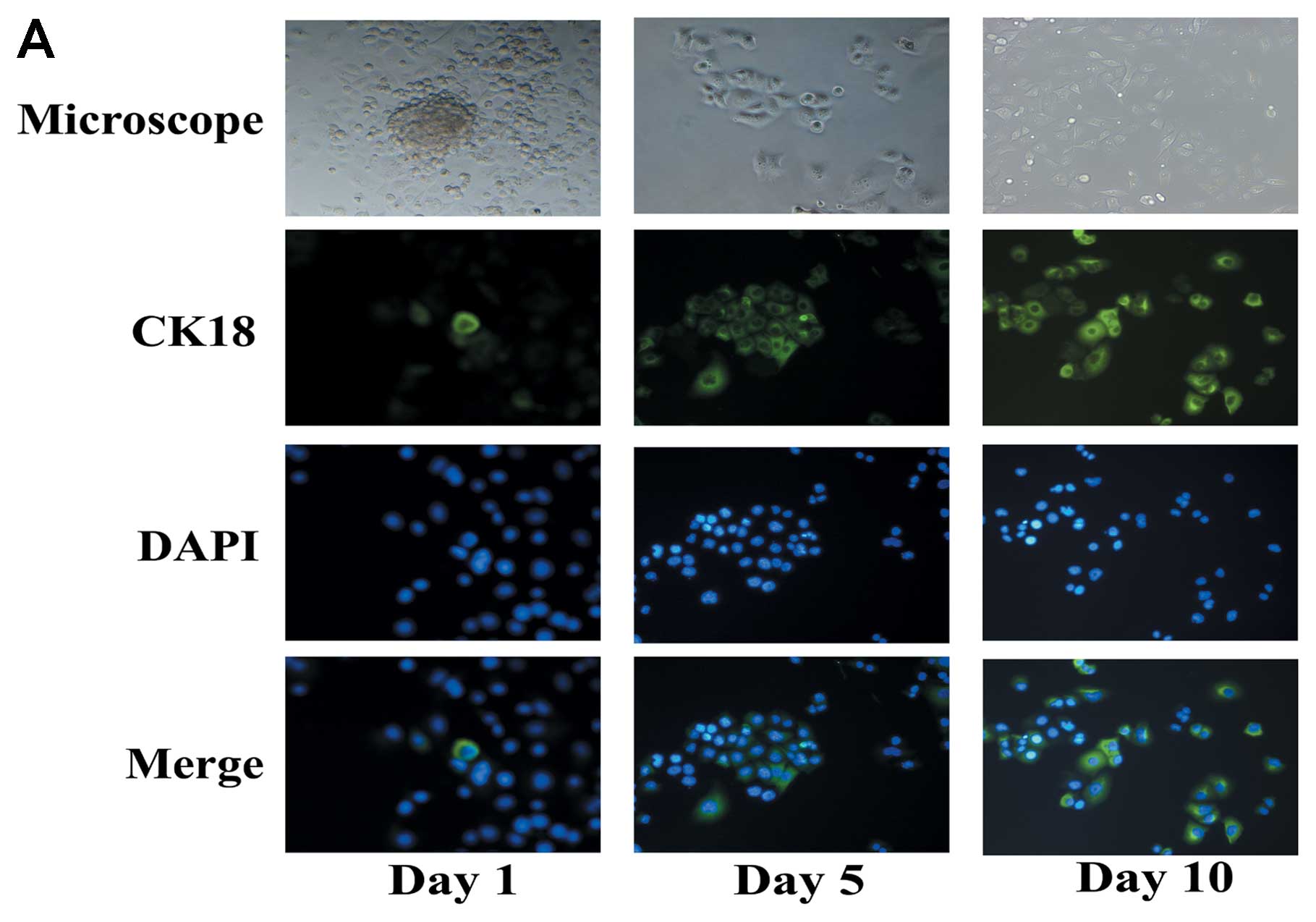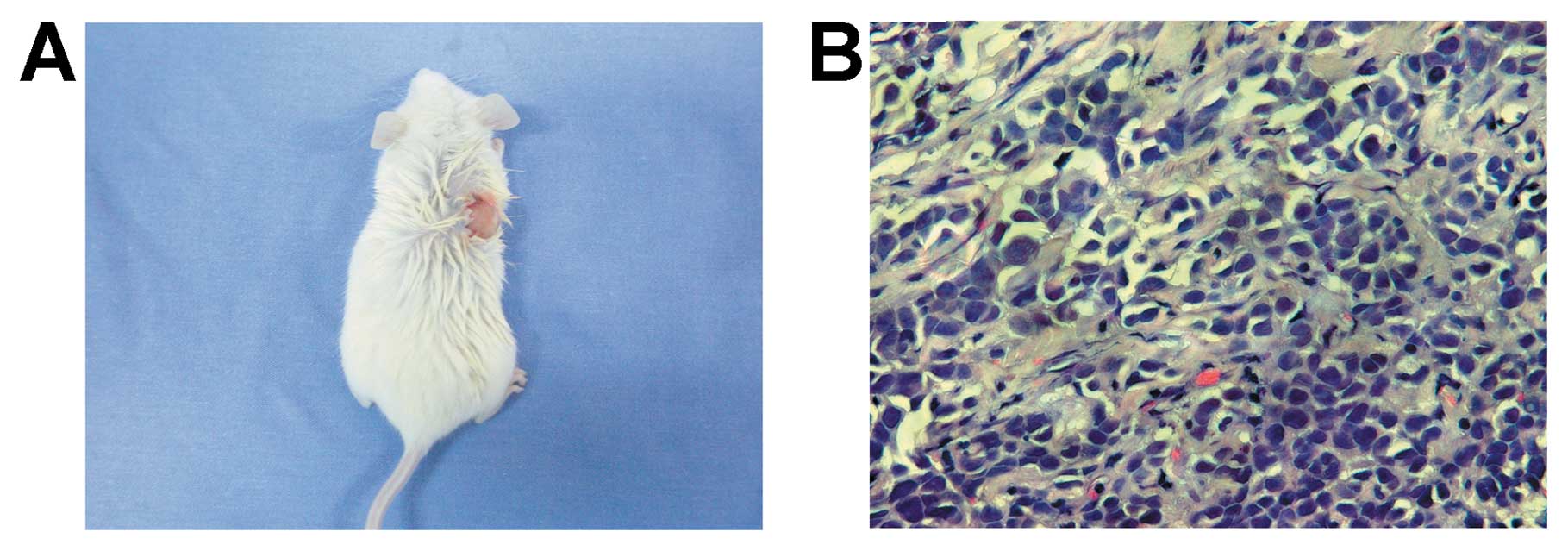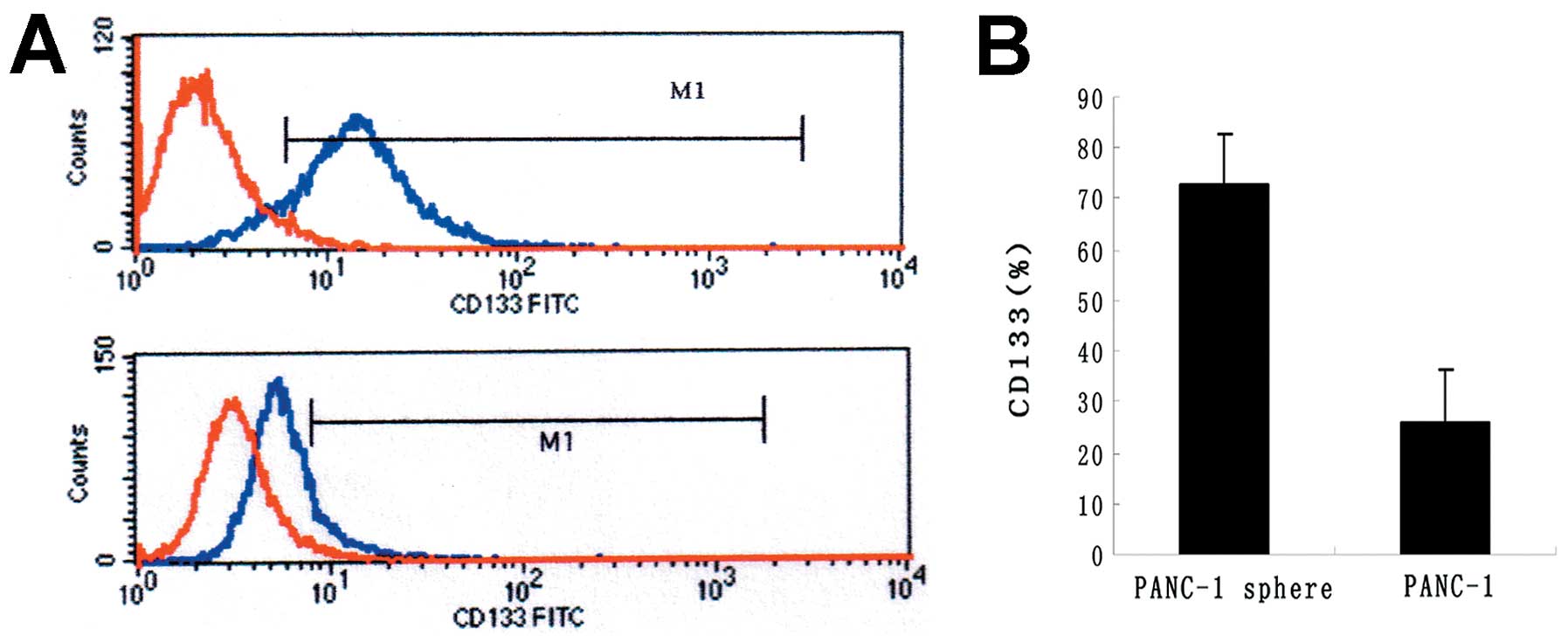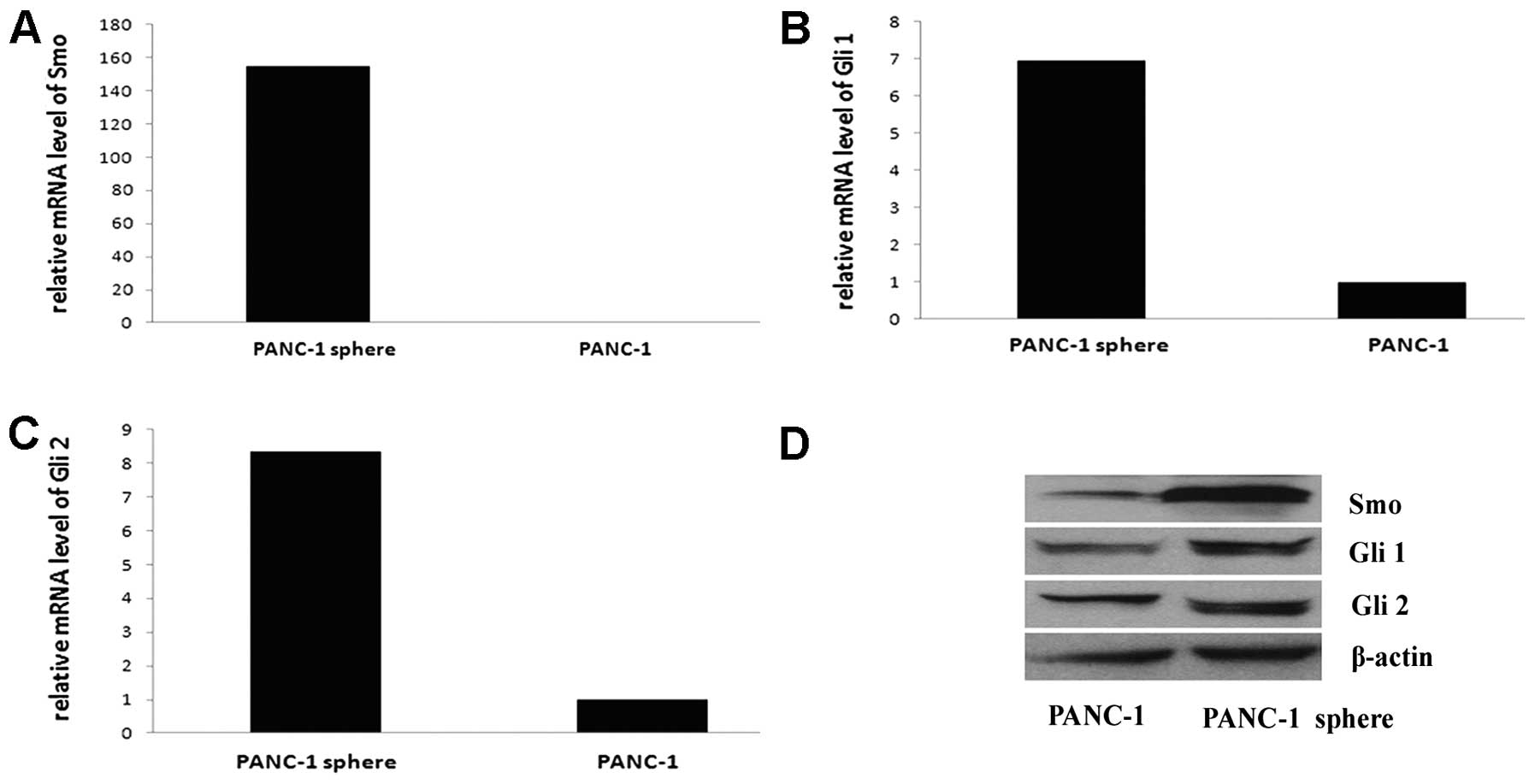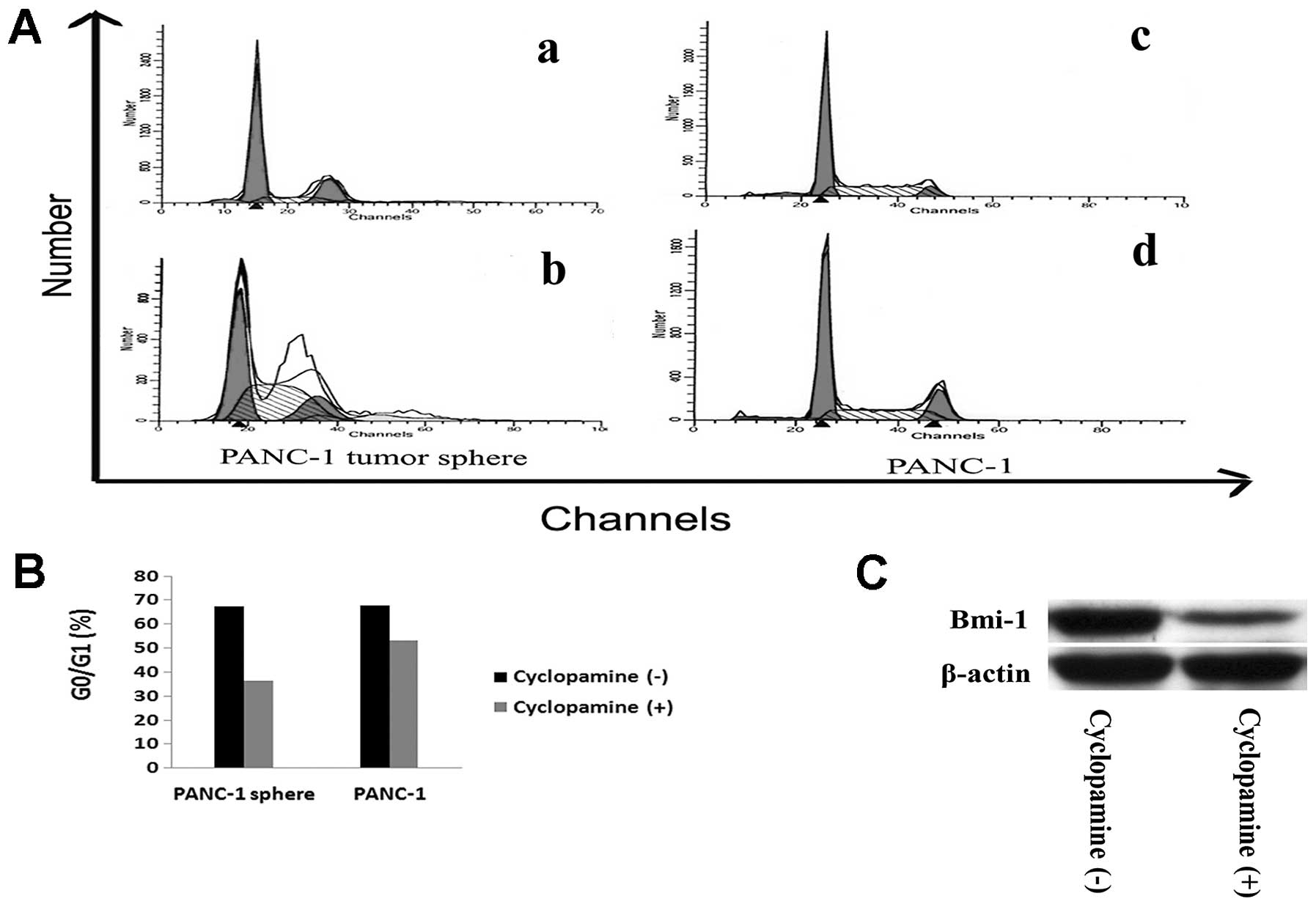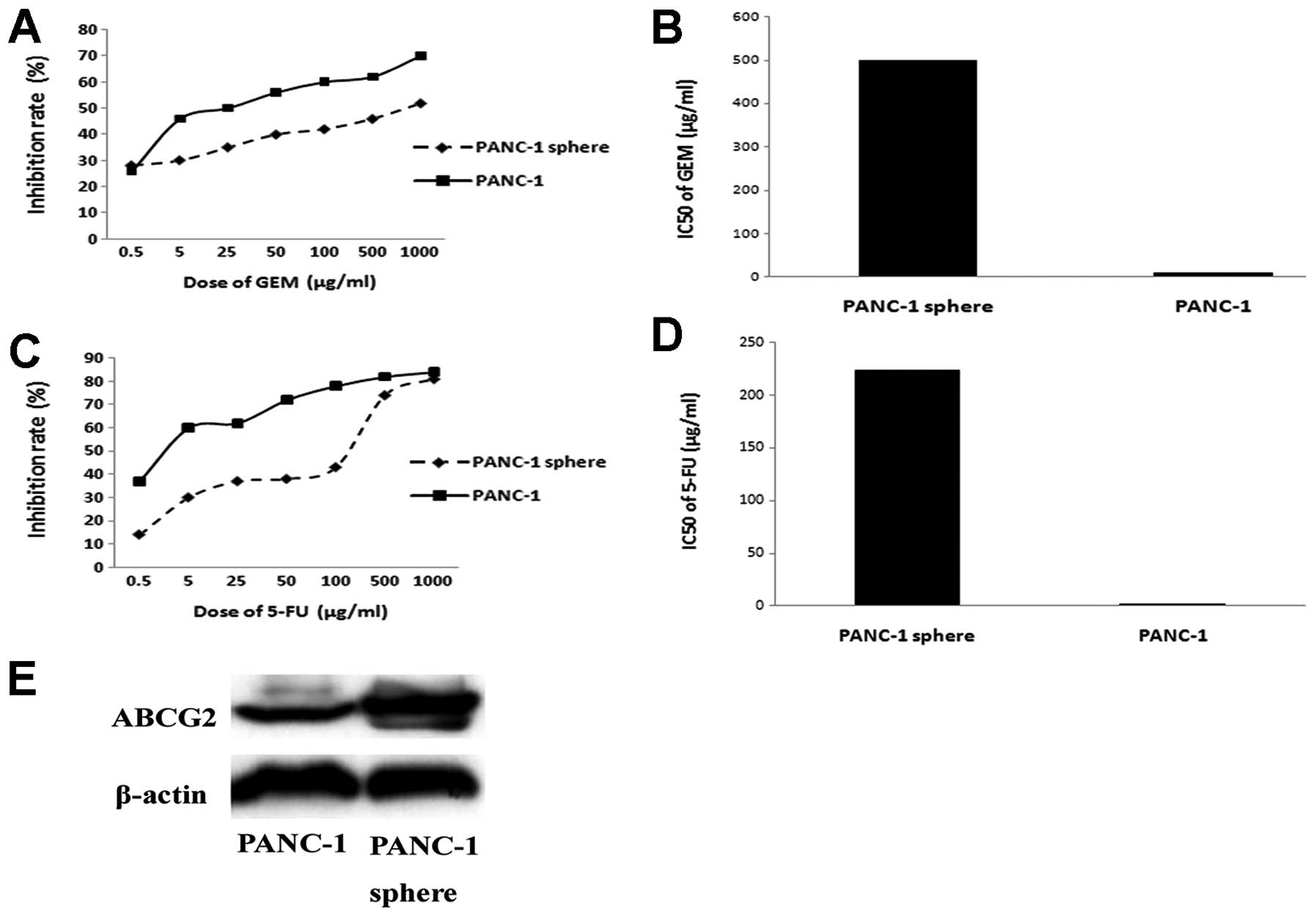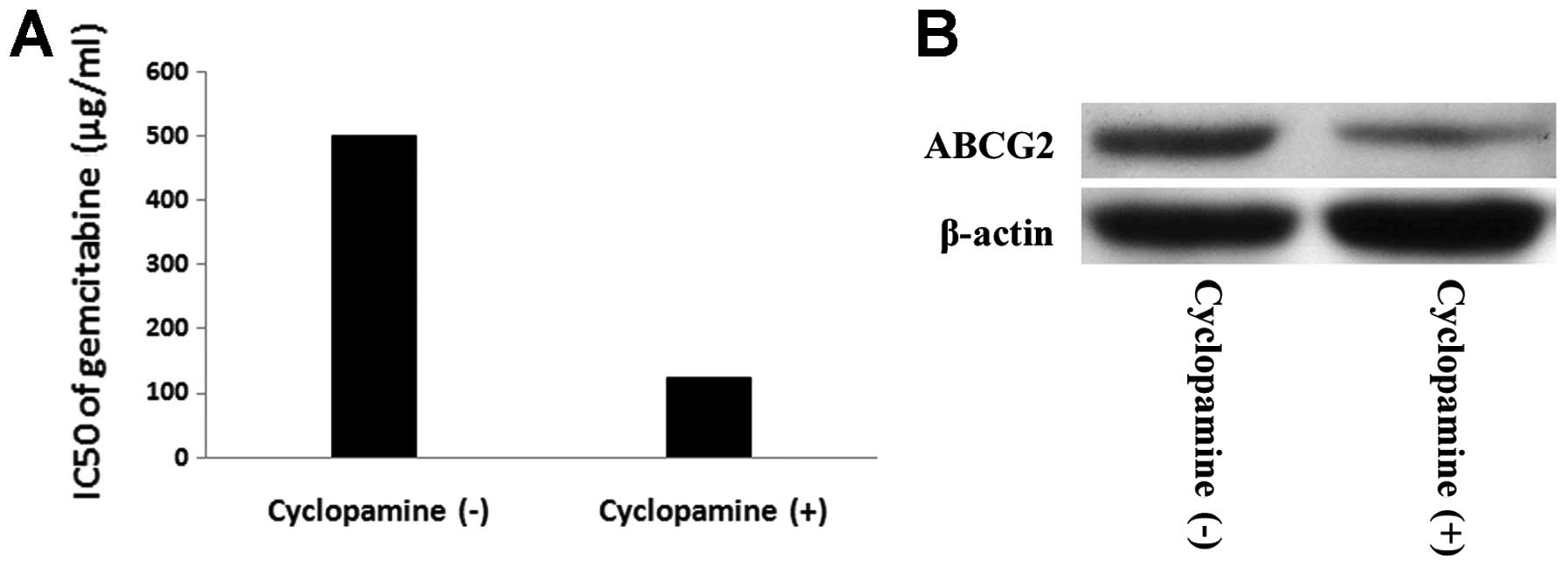Inhibition of hedgehog signaling depresses self-renewal of pancreatic cancer stem cells and reverses chemoresistance
- Authors:
- Published online on: August 22, 2012 https://doi.org/10.3892/ijo.2012.1597
- Pages: 1707-1714
Abstract
Introduction
Pancreatic cancer (PC) is one of the most malignant tumors. It is the fourth leading cause of cancer death in the United States (1) and has an increasing trend of mortality rate in China (2). Due to the lack of obvious symptoms or specific manifestation in the early stage, the disease is often diagnosed too late to have available therapeutic intervention options.
Cancer stem cells (CSCs) are a small subpopulation of multipotent cells exhibiting self-renewal capacity, multilineage differentiation and high carcinogenesis (3,4), and have been identified in several types of human cancers including pancreatic cancer (5–8). Tumorsphere under suspension culture is one of the important techniques to isolate cancer stem cell. Dysregulation of CSC self-renewal may lead to expansion of the stem-like cells, which might result in early-stage carcinogenesis (9,10). Chemoresistance of CSCs is one of the most critical reasons leading to failure of chemotherapy, which might be followed by tumor recurrence.
Hedgehog (Hh) family members are key regulators of carcinogenesis (4,11). Hh signal transduction is initiated by binding Hh ligand, including Shh, Dhh and Ihh, to its receptor Patched (PTCH). In the absence of Hh protein, PTCH represses signal transduction by inhibiting Smoothened (Smo). When Hh ligand binds to PTCH receptor, inhibitory effects of PTCH on Smo diminish, Hh pathway is activated and the ultimate step is mediated by the zinc finger transcription factors-Gli family which turns on genes regulating cell cycle, and determinating cell-fate. Hh pathway is active in many tumors, such as medulloblastoma (12), glioma (13), gastric cancer (14) and pancreatic cancer (15). Increasing evidence supports that hedgehog pathway has a role in the maintenance and progression of pancreatic cancer (16–18). It also has a crucial role in reverse chemoresistance of some CSCs, such as CD34+ leukaemic cells (19) and glioblastoma CSCs (20), but the mechanism is still unclear.
The breast cancer resistance protein (BCRP/ABCG2), a member of the G-subfamiliy of the ATP-binding cassette (ABC)-transporter superfamily, is implied to be associated with multidrug resistance in some cancer stem cells, such as side population in lung cancer (21), and prostate tumorshpere (22). In some cancers, there is relationship between Hh pathway and ABCG2. In diffuse large B-cell lymphoma (23), ABCG2 is the target of Hh pathway.
In the present study, we isolated pancreatic tumorspheres under floating-culture system, and identified the stemness potential of self-renewal, differentiation, high carcinogenesis and chemoresistance. We elucidated the important role of Hedgehog pathway in regulation of self-renewal and chemoresistance of pancreatic CSCs.
Materials and methods
Cell lines and animals
The human pancreatic adenocarcinoma cell line PANC-1 (Chinese Academy of Sciences, Shanghai, China) was cultured in RPMI-1640 (Gibco, Grand Island, NY, USA) supplemented with 10% fetal bovine serum (FBS, HyClone, Logan, UT, USA), 100 U/ml penicillin G, and 100 μg/ml streptomycin. In all experiments, cells were maintained at 37°C in a humidified 5% CO2 air atmosphere. Male non-obese diabetic/severe combined immunodeficiency (NOD/SCID) mice (6-8 weeks) were purchased from Chinese Academy of Sciences (Beijing, China). Animal care and experimental protocols were performed in accordance with procedures and guidelines established by Chinese Academy of Sciences Experimental Animal Care Commission.
Expansion of PANC-1 tumorspheres
Viable, floating single cells were collected from the supernatant of PANC-1 cells by centrifugation at 1,000 rpm for 5 min and plated at 1,000 cells/ml in serum-free DMEM-F12 (Gibco) supplemented with 20 ng/ml recombinant human epidermal growth factor (rhEGF, Invitrogen, NY, USA), 0.4% bovine serum albumin (BSA, Sigma, St. Louis, MO, USA), 5 μg/ml insulin, 1:50 B27 supplement (Gibco, Invitrogen), 100 U/ml penicillin, and 100 mg/ml streptomycin. Cells grown in this condition as non-adherent spheres were enzymatically dissociated after 12 days by incubation in a trypsin-EDTA solution and then cultured to generate tumorspheres of the next generation. Differentiation was induced by culturing tumorsphere-derived cells in RPMI-1640 supplemented with 10% fetal bovine serum without rhEGF.
Sphere formation assay
PANC-1 tumorspheres and its parental cell line PANC-1 were dissociated, and 1,000 cells per well were plated in 6-well culture dishes in 5 ml DMEM-F12 medium with rhEGF. The number of spheres for each well was evaluated after 15 days of culture.
Immunofluorescence analysis
To detect the differential potential of PANC-1 tumorspheres, the spheres were cultured in DMEMF12 supplemented with 10% FBS. Observation of morphology was performed by microscope. The expression of CK18, a differentiation marker, was detected by immunofluorescence on 1st, 5th and 10th day. The cells were washed with PBS and fixed in 4% paraform for 15 min on ice. After two more phosphate-buffered solution (PBS) washes, the cells were covered with 0.5% Triton-100 for 15 min on ice, then washed with PBS and incubated with 5% non-fat milk for 1 h at room temperature to block non-specific binding of IgG. The cells were incubated with primary antibody anti-human CK18 (Cell Signaling Technology, Boston, MA, USA) for 2 h at room temperature, then washed with PBS and incubated with fluorochrome-conjugated secondary antibody at room temperature for 30 min in a dark chamber. The cells were washed with PBS and covered with DAPI to stain the nuclei. Random photographs were taken at ×200 magnification.
Tumorsphere xenografts
To explore the tumorigenic capacity, PANC-1 tumorsphere cells in concentrations ranging from 200 to 2×104 were injected into the subcutaneous space of the pad of NOD/SCID mice. Tumor growth was monitored every 2 days after the second week of inoculation. When the xenograft tumors had reached the desired size, mice were sacrificed and a portion of the tumor tissue was collected, fixed in 4% paraform, and embedded in paraffin for hematoxylin and eosin (H&E) staining to assess tumor pathology. Tumors of three animals were harvested per experiment.
Quantitative real-time RT-PCR (qRT-PCR)
To analyse the hedgehog pathway components, qRT-PCR was performed to examine the expression level of Smo, Gli 1 and Gli 2 mRNA in PANC-1 tumorspheres and PANC-1. Briefly, total RNA was extracted from the cells using TRIzol (Invitrogen, CA, USA) according to the manufacturer’s instructions. For qRT-PCR, 1 μl of gene primers with SYBR Green in 20 μl of reaction volume was applied. 18S ribosomal RNA was used as an endogenous control. Primers were designed as: Smo, forward, 5′-cat ccc tga ctg tga gat ca-3′; reverse, 5′-cac cat ctt ggt gac atg ct-3′. Gli 1, forward, 5′-cca tac atg tgt gag cac ga-3′; reverse, 5′-ggc aca gtc agt ctg ctt t-3′. Gli 2, forward, CAA CGC CTA CTC TCC CAG AC; reverse, GAG CCT TGA TGT ACT GTA CCA C. QRT-PCR was performed with SYBR Green PCR System (Toyobo). Amplification data were analyzed with Applied Biosystems Prism Sequence Detection Software version 2.1 (Applied Biosystems).
Cell proliferation assay by WST-8 method
PANC-1 tumor-spheres were harvested and dissociated into single cell suspension, 3×104 PANC-1 sphere cells were seeded in 96-well plate per well. PANC-1 was also dissociated into single cell suspension, 3×103 cells were seeded in 96-well plate per well. The cells were treated in different concentration of cyclopamine (Sigma-Aldrich, St. Louis, MO) (0, 0.5, 1, 2, 5 and 10 μmol/l, respectively) in triplicate for 24, 48 and 72 h, respectively. WST-8 reagent (10 μl per well) from Cell Counting kit-8 (Dojindo, Kumamoto, Japan) was added, incubated for 4 h, and absorbance was determined with a multi-well spectrophotometer (BioTek, VT, USA) at 450 and 630 nm. Inhibition rate = (1 - absorbance of treated cells/control cells) ×100%.
Western blot analysis
The concentration of total protein extracted from PANC-1 and PANC-1 tumorsphere cells with and without cyclopamine was determined with a BCA Protein Assay kit (Pierce, USA). Equal amounts of protein were separated by 10% SDS-PAGE and electrophoretically transferred to PVDF membranes (Millipore, Bedford, MA, USA) using a mini trans-blot. Rat anti-human CK18 (Cell Signaling Technology), Bmi-1 (Abcam, MA, USA), ABCG2 (Abcam), Smo (Abcam), rabbit anti-human Gli 1 (Santa Cruz Biotechnology, Santa Cruz, CA, USA) and Gli 2 (Santa Cruz Biotechnology) were used to detect the expression of homologous proteins. β-actin (Santa Cruz Biotechnology) was used as an internal control. Electrochemiluminescence was performed with a Chemilmager 5500 imaging system (San Leandro, CA, USA), according to the manufacturer’s instructions.
Flow cytometry analysis
To detect the influence of tumorspheres on cell cycle after treatment of cyclopamine, flow cytometry analysis was performed. Briefly, tumorsphere cells and PANC-1 were treated with 10 μmol/l cyclopamine for 72 h. Then the cells were trypsinized and fixed with ice-cold 70% ethanol for 18 h at 4°C. The fixed cells were stained with 50 mg/ml propidium iodide (BD Pharmingen, San Diego, CA) and 50 mg/ml RNase and then analysed using a flow cytometer (BD Pharmingen). PANC-1 tumorspheres and PANC-1 without cyclopamine incubation were performed as control.
CD133 is implied as a stem cell marker in many tumors, to detect phenotypic difference of CD133 in PANC-1 and PANC-1 spheres, cells were harvested with trypsin-EDTA to produce a single cell suspension. The cells were pelleted by centrifugation, washed twice with PBS and incubated with FITC conjugated CD133 (Ancell, Bayport, MN, USA) for 30 min in the dark. The cells were washed twice with PBS after incubation and analyzed using a flow cytometer.
Statistical analysis
Data are presented as mean ± standard deviation (SD), using the SPSS software, version 11.0. The means were then compared using a one-way ANOVA with LSD among groups or Student’s t-test between groups. P<0.05 was considered statistically significant.
Results
PANC-1 tumorspheres cultured under floating-culture system possess self-renewal potential
One of the probable method to identify the CSCs is serum-free floating-culture system. It was sucessfully used to culture neural stem cell and other cancer stem cells, such as breast CSCs and brain CSCs. We applied this method to isolate PANC-1 tumorspheres from human pancreatic cancer cell line PANC-1. The adherent PANC-1 was trypsinized into single-cell suspension, and was seeded in serum-free media supplemented with growth factors at clonal density (1,000 cells/ml). Five days later, PANC-1 tumorspheres began to form in culture and they propagated after 10-15 days (Fig. 1). The 1st spheres could be enzymatically dissociated into single cells, which in turn generated the 2nd spheres. This procedure could be repeated and the PANC-1 tumorspheres have been passaged over 20 times in vitro.
We subsequently examined whether PANC-1 tumorsphere cells possess self-renewal capacity. Sphere formation assay was performed to calculate the number of stem cell spheres and measure the self-renewal capacity of each sphere generation. Each generation of tumorsphere cells (103) were plated in 6-well dish, and cultured for 15 days in triplicate. The 1st PANC-1 tumorsphere cells form 5.5±1.3 spheres; The 4th PANC-1 tumorsphere cells form 4.5±1.3 spheres (P>0.05). The capacity of serial-passage in vitro and the number of tumorspheres that remained equivalent show the self-renewal potential of PANC-1 tumorspheres.
PANC-1 tumorspheres have differentiation potential
Differentiation potential is one of the capacites of CSCs. CK18 is a mature marker associated to luminal/ductal epithelial cells, and acts as a differentiation marker in this study. Both immunofluorescence analysis and western blot analyses were performed to detect the expression of CK18. To induce differentiation, floating PANC-1 tumorspheres were cultured in the medium without growth factors and with 10% fetal bovine serum. Under differentiating conditions, floating PANC-1 tumorspheres began to adhere and acquired epithelium-like morphology. Expression of CK18 was increased after induction of differentiation (Fig. 2).
PANC-1 tumorspheres have higher tumorigenic potential
High tumorigenic potential is one of the characteristics of CSCs. To detect the tumorigenicity of PANC-1 tumorspheres, a concentration ranging from 200 to 2×104 tumorsphere cells were injected into the subcutaneous space of the pad of NOD/SCID mice. After 11 weeks, 2×103 PANC-1 tumorsphere cells initiated a tumor in 1 of 3 NOD/SCID mice (Fig. 3). Whereas, ≥105 PANC-1 cells initiated a tumor in NOD/SCID mice (Table I). The data imply that PANC-1 tumorsphere cells are more tumorigenic than its parental cell line. Collectively, floating PANC-1 tumorspheres have potential of self-renewal, differentiation and high tumori-genesis, which are the characteritics of CSCs.
CD133 is highly expressed in PANC-1 tumorspheres
CD133 is well-known as stem cell marker in many tumors. To detect the phenotypic difference between PANC-1 tumorspheres and PANC-1, FACS was carried out. The CD133+ subfraction was dramatically increased in PANC-1 tumorspheres compared with PANC-1 (72.73±4.38 vs 26.16±2.13%) (P<0.05) (Fig. 4).
The Hh pathway is active in PANC-1 tumorspheres
Hh pathway is active in some CSCs, such as glioma CSCs and breast CSCs. Also, Hh pathway is active in pancreatic ductal adenocarcinoma. To evaluate the possibility that Hh signaling is active in pancreatic CSCs, we examined the expression of Smo, Gli 1 and Gli 2 mRNA and protein in PANC-1 tumorspheres and PANC-1 cells by qRT-PCR and western blotting. Hh pathway is active in both PANC-1 tumorspheres and PANC-1 cells, Smo, Gli 1 and Gli 2 mRNA are high expressed, especially in PANC-1 tumorspheres, the expression of Smo mRNA is 154.76-fold as that of PANC-1 cells, the expression of Gli 1 mRNA is 6.94-fold that of PANC-1 cells and Gli 2 is 8.36-fold. The results of western blot analysis are consistent with the mRNA expression (Fig. 5).
Cyclopamine-mediated blockade of Hh pathway inhibits proliferation of PANC-1 CSCs via Bmi-1
To detect the effects on inhibition of Hh pathway, we used cyclopamine, a special inhibitor of Smo, to block the Hh pathway. PANC-1 tumorsphere cells were treated in different concentration of cyclopamine (0, 0.5, 1, 2, 5 and 10 μmol/l, respectively) in triplicate for different times (24, 48 and 72 h). Cyclopamine-mediated Hh pathway blockade inhibited the overall growth rate of the culture in a dose-and time-dependent fashion. After treatment with 10 μmol/l cyclopamine for 72 h, the inhibition rate of PANC-1 tumorsphere cells was (37.85±13.69)% (P<0.05). Furthermore, to investigate whether cell cycle of PANC-1 tumorsphere cells change after cyclopamine treatment, flow cytometry was performed to detect the cell cycle of tumorspheres with and without cyclopamine. After incubation with 10 μmol/l cyclopamine for 72 h, percentage of G0/G1 of PANC-1 tumorspheres was decreased (36.53±6.03)%, compared to (67.41±6.35)% before incubation (P<0.05) (Fig. 6A and B). We hypothesized that Bmi-1 may function as a downstream target of the Hh pathway. To test the hyposis, we examine the expression of Bmi-1 protein of PANC-1 tumor-spheres with and without cyclopamine incubation by western blotting. After incubation with 10 μmol/l cyclopamine for 72 h, expression of Bmi-1 protein was reduced (Fig. 6C).
Cyclopamine reverses chemoresistance of PANC-1 tumor-spheres via ABCG2
Drug sensitivity assay was carried out to detect the chemotherapy resistance of PANC-1 tumorspheres and its parental cell line PANC-1. PANC-1 tumorspheres are more resistant to gemcitabine and 5-FU than PANC-1. IC50 of gemcitabine in PANC-1 tumorspheres is 500.75±10.51 μg/ml, while PANC-1 is 11.43±2.10 μg/ml (P<0.05). IC50 of 5-FU in PANC-1 tumorspheres and PANC-1 is 224.37±5.71 μg/ml vs 2.19±0.32 μg/ml (P<0.05). Expression of ABCG2 is detected by western blotting. As shown, expression of ABCG2 in PANC-1 tumorspheres is much higher than that of PANC-1 (Fig. 7). Moreover, we investigated whether inhibition of Hh pathway could reverse chemoresistance of PANC-1 tumorspheres, and we used cyclopamine to block the Hh pathway. PANC-1 tumor-sphere cells preincubated with 10 μmol/l cyclopamine for 72 h were treated with different concentration of gemcitabine (0, 0.5, 5, 25, 50, 100, 500 and 1000 μg/ml) for 72 h. IC50 of gemcitabine in PANC-1 tumorspheres with and without cyclopamine is 124.55±12.37 μg/ml vs 500.75±10.51 μg/ml (P<0.05). We hypothesized the expression of ABCG2 in PANC-1 tumorsphere cells changed after cyclopamine treatment. To consolidate this notion, western blot analysis was performed to detect expression of ABCG2 protein of tumorspheres with and withdrawl cyclopa-mine. PANC-1 tumorsphere after incubation with cyclopamine displayed significantly reduced levels of ABCG2 compared to tumorspheres without cyclopamine incubation (P<0.05) (Fig. 8).
Discussion
Accumulating evidence has demonstrated that a tumor is in essence heterogeneous and contains cancer stem cells which possess the potential of self-renewal, multilineage differentiation, high proliferation, and chemoresistance. More and more studies support existance of tumor-initiating cells in pancreatic adenocarcinoma (7,8). Serum-free floating culture system has been used to identify CSCs in several cancer types such as brain cancer, breast cancer and colon cancer (24–26). The cells isolated using this system were proved to have the stem cell features and represent the small population in tumors which was the reason of tumor formation, metastasis and resistance to chemotherapy. The advantage of this strategy to enrich CSCs is its independence of specific cell surface markers. In our study, we isolated PANC-1 tumor-spheres under floating-culture system, and it could be serially propagated in vitro over 20 passages. Sphere formation assay showed that the number of spheres kept equivalent when being propagated in vitro. Under differentiating conditions, PANC-1 tumorspheres were adherent and differentiated. They acquired epithelial morphology and expressed mature marker CK18 associated to luminal/ductal cells. More CK18 was expressed when the time of differentiation was extended. Furthermore, as few as 2×103 PANC-1 sphere cells initiated a tumor in NOD/SCID mice, a 100-fold enhanced tumorigenic potential compared to its parental cell line, which is in accordance with Li et al (7). Taken together, PANC-1 tumorspheres displayed potential of self-renewal, differentiation and high tumorigenicity, which are the characteristics of cancer stem cells.
Hedgehog signal pathway is active in pancreatic cancer (27), also it is active in many CSCs, such as prostate CSCs (28), and glioblastoma CSCs (20). Hedgehog has been associated with the self-renewal process of CSCs (29). B lymphoma Mo-MLV insertion region 1 (Bmi-1), a transcriptional repressor belonging to the polycomb group (PCG) of transcription factors, has been reported to play a key role in regulating self-renewal of leukemic stem cell (30) and breast CSCs (23). It is reported that the Hh pathway regulates self-renewal of human medulloblastoma brain tumor-initiating cells via Bmi-1 (31). In our study, inhibition of Hh pathway depressed self-renewal of the PANC-1 tumorsphere. To illustrate whether Hh regulates PANC-1 tumorsphere via Bmi-1, we examined the expression of Bmi-1 with and without cyclopamine-mediated blockade of Hh. Expression of Bmi-1 was reduced after blockade of the Hh pathway. Taken together, these data suggested that Hedgehog pathway and Bmi-1 might be involved in pancreatic tumorigenesis.
It is reported that CSCs are naturally chemoresistant (32). ABCG2 with drug capability are preferentially expressed in CSCs. Also, the chemoresistant phenotype of CSCs can be mediated by ABCG2 protein. Hh pathway was illustrated to have a relationship with chemoresistance of pancreatic cancer stem cells (33), and ABCG2 is reported to be the direct transcriptional target of Hh pathway in drug tolerance in diffuse large B-cell lymphoma (34). In our study, we found that PANC-1 tumorspheres were more resistant to gemcitabine and 5-FU compared to PANC-1. Expression of ABCG2 was significantly elevated in PANC-1 tumorspheres. Blockade of Hh pathway by cyclopamine reversed chemoresistance of gemcitabine in PANC-1 tumorspheres. Moreover, expression of ABCG2 was decreased after cyclopamine incubation. Hence, it was implied in our study that inhibition of Hh pathway reversed chemoresistance in PANC-1 tumorspheres via ABCG2.
In conclusion, our study illustrated that tumorspheres derived from pancreatic cancer cell line PANC-1 possessed self-renewal, chemoresistance and other stemness properties. Hh pathway was active in PANC-1 tumorspheres. More importantly, our data suggested that inhibition of Hh pathway depressed self-renewal of pancreatic CSCs via Bmi-1, which might be involved in pancreatic tumorigenesis. Our study also demonstrated the crucial role of Hh pathway of pancreatic CSCs in mediating chemotherapy resistance associated with ABCG2.
Acknowledgements
We would like to thank Dr Jing Wei for assistance with flow cytometry. This research was supported in part by a grant from the Natural Science Foundation of Guangdong Province (no. 815100890100013, 04009381) and Medical Scientific Research Foundation of Guangdong Province (no. B2009066).
References
|
Greenlee RT, Murray T, Bolden S and Wingo PA: Cancer statistics. CA Cancer J Clin. 50:7–33. 2000. | |
|
Wang L, Yang GH, Lu XH, Huang ZJ and Li H: Pancreatic cancer mortality in China (1991-2000). World J Gastroenterol. 9:1819–1823. 2003. | |
|
Reya T, Morrison SJ, Clarke MF and Weissman IL: Stem cells, cancer, and cancer stem cells. Nature. 414:105–111. 2001. View Article : Google Scholar : PubMed/NCBI | |
|
Beachy PA, Karhadkar SS and Berman DM: Tissue repair and stem cell renewal in carcinogenesis. Nature. 432:324–331. 2004. View Article : Google Scholar : PubMed/NCBI | |
|
Al-Hajj M, Wicha MS, Benito-Hernandez A, Morrison SJ and Clarke MF: Prospective identification of tumorigenic breast cancer cells. Proc Natl Acad Sci USA. 100:3983–3988. 2003. View Article : Google Scholar : PubMed/NCBI | |
|
Singh SK, Hawkins C, Clarke ID, et al: Identification of human brain tumour initiating cells. Nature. 432:281–282. 2004. View Article : Google Scholar | |
|
Li CW, Heidt DG, Dalerba P, et al: Identification of pancreatic cancer stem cells. Cancer Res. 67:1030–1037. 2007. View Article : Google Scholar : PubMed/NCBI | |
|
Hermann PC, Huber SL, Herrler T, et al: Distinct populations of cancer stem cells determine tumor growth and metastatic activity in human pancreatic cancer. Cell Stem Cell. 1:241–242. 2007. View Article : Google Scholar : PubMed/NCBI | |
|
Dontu G, Al-Hajj M, Abdallah WM, Clarke MF and Wicha MS: Stem cells in normal breast development and breast cancer. Cell Prolif. 36:59–72. 2003. View Article : Google Scholar : PubMed/NCBI | |
|
Wicha MS, Liu S and Dontu G: Cancer stem cells: an old idea - a paradigm shift. Cancer Res. 66:1883–1890. 2006. View Article : Google Scholar : PubMed/NCBI | |
|
Berman DM, Karhadkar SS, Maitra A, et al: Widespread requirement for hedgehog ligand stimulation in growth of digestive tract tumors. Nature. 425:846–851. 2003. View Article : Google Scholar : PubMed/NCBI | |
|
Berman DM, Karhadkar SS, Hallahan AR, et al: Medulloblastoma growth inhibition by hedgehog pathway blockade. Science. 297:1559–1561. 2002. View Article : Google Scholar : PubMed/NCBI | |
|
Clement V, Sanchez P, de Tribolet N, Radovanovic I and Ruiz i Altaba A: HEDGEHOG-GLI1 signaling regulates human glioma growth, cancer stem cell self-renewal, and tumorigenicity. Curr Biol. 17:165–172. 2007. View Article : Google Scholar : PubMed/NCBI | |
|
Han ME, Lee YS, Baek SY, Kim BS, Kim JB and Oh SO: Hedgehog signaling regulates the survival of gastric cancer cells by regulating the expression of Bcl-2. Int J Mol Sci. 10:3033–3043. 2009. View Article : Google Scholar : PubMed/NCBI | |
|
Thayer SP, di Magliano MP, Heiser PW, et al: Hedgehog is an early and late mediator of pancreatic cancer tumorigenesis. Nature. 425:851–856. 2003. View Article : Google Scholar : PubMed/NCBI | |
|
Jones S, Zhang X, Parsons DW, et al: Core signaling pathways in human pancreatic cancers revealed by global genomic analyses. Science. 321:1801–1806. 2008. View Article : Google Scholar : PubMed/NCBI | |
|
Feldmann G, Habbe N, Dhara S, et al: Hedgehog inhibition prolongs survival in a genetically engineered mouse model of pancreatic cancer. Gut. 57:1420–1430. 2008. View Article : Google Scholar : PubMed/NCBI | |
|
Jimeno A, Feldmann G, Suárez-Gauthier A, et al: A direct pancreatic cancer xenograft model as a platform for cancer stem cell therapeutic development. Mol Cancer Ther. 8:310–314. 2009. View Article : Google Scholar : PubMed/NCBI | |
|
Liu S, Dontu G, Ilia D, Mantle ID, et al: Hedgehog signaling and Bmi-1 regulate self-renewal of normal and malignant human mammary stem cells. Cancer Res. 66:6063–6071. 2006. View Article : Google Scholar : PubMed/NCBI | |
|
Bar EE, Chaudhry A, Lin A, et al: Cyclopamine-mediated hedgehog pathway inhibition depletes stem-like cancer cells in glioblastoma. Stem Cells. 25:2524–2533. 2007. View Article : Google Scholar : PubMed/NCBI | |
|
Shi Y, Fu X, Hua Y, Han Y, Lu Y and Wang J: The side population in human lung cancer cell line NCI-H460 is enriched in stem-like cancer cells. PLoS One. 7:e333582012. View Article : Google Scholar : PubMed/NCBI | |
|
Zhang L, Jiao M, Li L, et al: Tumorspheres derived from prostate cancer cells possess chemoresistant and cancer stem cell properties. J Cancer Res Clin Oncol. 138:675–686. 2012. View Article : Google Scholar : PubMed/NCBI | |
|
Park IK, Qian D, Kiel M, et al: Bmi-1 is required for maintenance of adult self-renewing haematopoietic stem cells. Nature. 423:302–305. 2003. View Article : Google Scholar : PubMed/NCBI | |
|
Inagaki A, Soeda A, Oka N, et al: Long-term maintenance of brain tumor stem cell properties under at non-adherent and adherent culture conditions. Biochem Biophys Res Commun. 361:586–592. 2007. View Article : Google Scholar : PubMed/NCBI | |
|
Ponti D, Costa A, Zaffaroni N, et al: Isolation and in vitro propagation of tumorigenic breast cancer cells with stem/progenitor cell properties. Cancer Res. 65:5506–5511. 2005. View Article : Google Scholar : PubMed/NCBI | |
|
Ricci-Vitiani L, Lombardi DG and Pilozzi E: Identification and expansion of human colon-cancer-initiating cells. Nature. 445:111–115. 2007. View Article : Google Scholar : PubMed/NCBI | |
|
Inaguma S, Kasai K and Ikeda H: GLI1 facilitates the migration and invasion of pancreatic cancer cells through MUC5AC-mediated attenuation of E-cadherin. Oncogene. 30:714–723. 2011. View Article : Google Scholar : PubMed/NCBI | |
|
Chang HH, Chen BY, Wu CY, et al: Hedgehog overexpression leads to the formation of prostate cancer stem cells with meta-static property irrespective of androgen receptor expression in the mouse model. J Biomed Sci. 18:62011. View Article : Google Scholar | |
|
Takebe N, Harris PJ, Warren RQ and Ivy SP: Targeting cancer stem cells by inhibiting Wnt, Notch, and Hedgehog pathways. Nat Rev Clin Oncol. 8:97–106. 2011. View Article : Google Scholar : PubMed/NCBI | |
|
Dimri GP, Martinez JL, Jacobs JJ, et al: The Bmi-1 oncogene induces telomerase activity and immortalizes human mammary epithelial cells. Cancer Res. 62:4736–4745. 2002.PubMed/NCBI | |
|
Wang X, Venugopal C, Manoranjan B, et al: Sonic hedgehog regulates Bmi1 in human medulloblastoma brain tumor-initiating cells. Oncogene. 31:187–199. 2012. View Article : Google Scholar : PubMed/NCBI | |
|
Rich JN and Bao S: Chemotherapy and cancer stem cells. Cell Stem Cell. 1:353–355. 2007. View Article : Google Scholar : PubMed/NCBI | |
|
Yao J, An Y, Wie JS, et al: Cyclopamine reverts acquired chemoresistance and down-regulates cancer stem cell markers in pancreatic cancer cell lines. Swiss Med Wkly. 141:w132082011.PubMed/NCBI | |
|
Singh RR, Kunkalla K, Qu C, Schlette E, Neelapu SS, Samaniego F and Vega F: ABCG2 is a direct transcriptional target of hedgehog signaling and involved in stroma-induced drug tolerance in diffuse large B-cell lymphoma. Oncogene. 30:4874–4886. 2011. View Article : Google Scholar : PubMed/NCBI |




